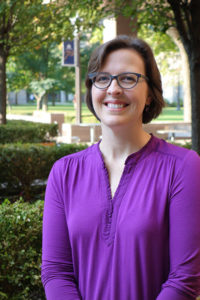“We are in fact convinced that no human experience is without meaning or unworthy of analysis, and that the fundamental values, even if they are not positive, can be deduced from the particular world which we are describing.”
–Primo Levi, If This is a Man
In Se questo è un uomo (If This is a Man), Primo Levi articulates that all experience informs our thinking and understanding about what it means to be human. Levi’s own experience as a chemist and a human subjected to extreme suffering in Auschwitz resonates throughout his works on display here.
 Elements of Humanity: Primo Levi and the Evolution of Italian Postwar Culture, the current exhibit in Special Collections to commemorate the 30th anniversary of Levi’s death, is curated by Tracy Bergstrom with assistance from Vittorio Montemaggi (Lecturer, Religion and the Arts, King’s College London) and Valentina Geri (PhD candidate, Italian). Tracy is the Program Director for the Specialized Collection Services Program and the curator of the Zahm Dante and early Italian imprints collection at Notre Dame. She earned a Bachelor of Arts in Italian Studies and Art History from Smith College, a Master of Arts in Archaeological Studies from Yale University, and a Master of Library Science from Southern Connecticut State University.
Elements of Humanity: Primo Levi and the Evolution of Italian Postwar Culture, the current exhibit in Special Collections to commemorate the 30th anniversary of Levi’s death, is curated by Tracy Bergstrom with assistance from Vittorio Montemaggi (Lecturer, Religion and the Arts, King’s College London) and Valentina Geri (PhD candidate, Italian). Tracy is the Program Director for the Specialized Collection Services Program and the curator of the Zahm Dante and early Italian imprints collection at Notre Dame. She earned a Bachelor of Arts in Italian Studies and Art History from Smith College, a Master of Arts in Archaeological Studies from Yale University, and a Master of Library Science from Southern Connecticut State University.
The exhibit invites viewers to engage with the works on display to explore Levi’s life and work. Tracing the development of Levi’s writings and their reception, Elements of Humanity demonstrates how they are interconnected. The books on display challenge viewers to reflect on what they see, on how art and history are related, on the connections between truth and fiction, on the relationship between scientific and humanistic knowledge.
Elucidating this synthesis is Levi’s Il sistema periodico (The Periodic Table). His scientific knowledge and analysis are woven with his literary skills, illuminating his experiences—personal, social, and political. In the series of short stories, each bears the name of an element which Levi uses as a metaphor for particular experiences from his life. On display, set in front of stunning images created by the Japanese artist, Yosuke Taki, is the opening of “Carbon” in which Levi traces the journey of a single carbon atom across time and space, a journey reflecting the experiences of the writer himself.
Most of the books in this exhibit are part of the Primo Levi Collection in Special Collections. Beginning in 2009, Hesburgh Libraries and Italian Studies partnered to develop this as a new collection that deepened the Italian holdings’ reach to include contemporary Italian literature. At the launch for this collection in Fall 2011, Father Hesburgh spoke about the importance of Notre Dame holding such a collection to use for teaching and research. The Levi Collection now includes all first editions of Levi’s works printed in Italy during his lifetime and of notable translations, especially in German and English, and adaptations that document Levi’s importance outside of Italy.
The Primo Levi Collection in addition to the Zahm Dante Collection and the other Italian literature collections held by the Libraries continue to support teaching and research for the campus and international visitors, and it also provides an invaluable resource for a new PhD program in Italian. These collections are heavily used by undergraduates, graduate students, and faculty at Notre Dame and by visiting scholars. Over the past few years, Italian Studies has made increasing use of these materials for the seminars it holds related to Italian Holocaust Studies. Of note, in 2012, Robert Gordon (Serena Professor of Italian at the University of Cambridge) examined the collection, gave a talk titled “Outrageous Fortune: Luck and the Holocaust,” and met with graduate students.
Works from the Italian literature collections have been exhibited on numerous occasions. Between 2008 and 2011, rotating exhibit cases featured topical exhibits: “Petrarch in 16th-Century Translation” and “Dante for Children.” A spotlight exhibit, “Plumb Crazy: Dante and Music,” ran October 3-28, 2016. “The Sixth Centenary Festival of Dante” was on display in Fall 2015, displaying works to commemorate the 600th anniversary in 1865 of Dante’s birth. Italian collections were also featured in All Roads Lead to Rome: New Acquisitions Relating to the Eternal City (Fall 2011).
Elements of Humanity opened on September 5, 2017 with remarks by Tracy Bergstrom, Vittorio Montemaggi, and Valentina Geri. The exhibit will remain on display through December 15, 2017. The exhibit is free and open to the public, Monday – Friday, 9am – 5pm.
Public Tours
• Tuesdays, noon
• Wednesdays, 3pm
Tours for classes or other groups, including K-12 requests, are available. Please contact Tracy Bergstrom at tbergstr@nd.edu or (574) 632-1763 to schedule a class or tour.
Suggested Resources
ETA: Tracy Bergstrom left the university in the spring of 2023.
